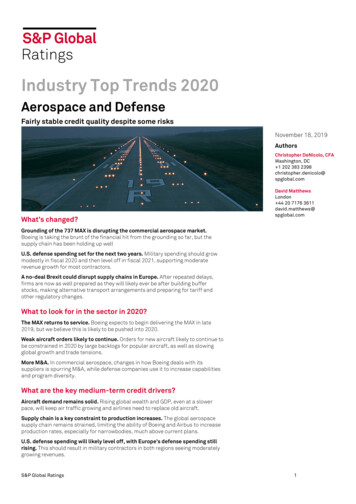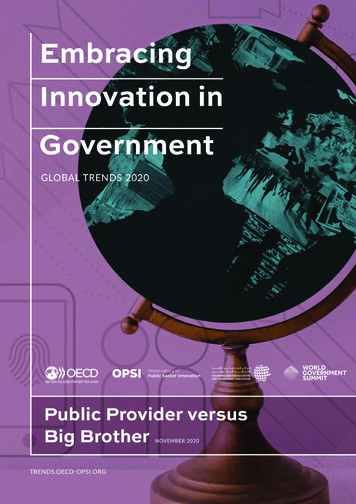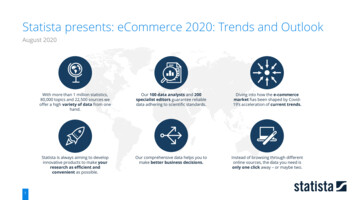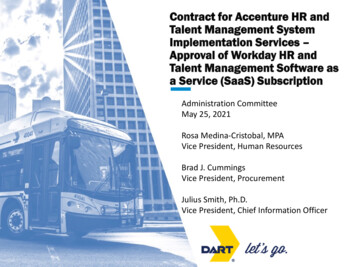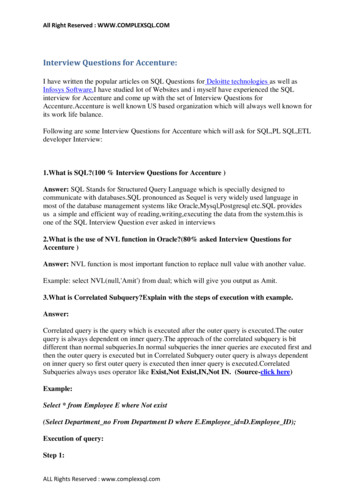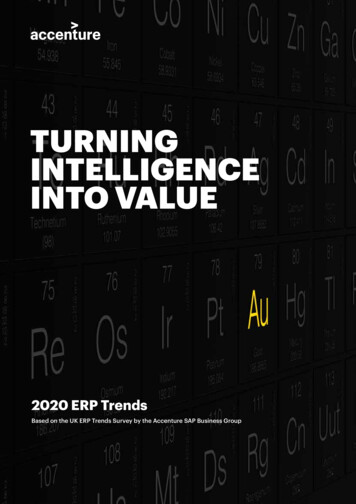
Transcription
2020 ERP TrendsBased on the UK ERP Trends Survey by the Accenture SAP Business Group1
TURNINGINTELLIGENCEINTO VALUE2020 ERP TRENDSFOREWORDWelcome to “Turning Intelligence into Value”,Accenture’s 2020 ERP trends report. Based on asurvey of 122 CIOs in the UK, this report offers deepinsights into how ERP solutions are being usednow, and how their future direction is changing.Now in its second year, the report highlights theevolving challenges and opportunities of today’sERP market.22
This is a market that continues to change and grow at speed. Accordingto Gartner research, “the ERP software market grew 10 per cent to aglobal market value of 35 billion in 2018”1. And that growth shows nosign of slowing. Gartner forecasts that the ERP market will be worth 44 billion by 20222.The cloud is the foundation of a modern ERP. And it will continue tobe so, as highlighted by developments like SAP’s new partnership withMicrosoft. The company is the first global cloud provider to join SAP’snew Embrace program to accelerate customer journeys to – and in –the cloud. Using cloud, companies are turning intelligent operationsinto value and bringing ERP capabilities out from the boiler roomto their customers.Despite this market momentum and these developing relationships,challenges remain. These include an imminent ERP talent shortage.By 2021, Gartner expects that ERP cloud enterprise applicationimplementation labour rates will increase by 60 per cent due to highdemand and a lack of skilled resources.3 Securing and building thecapability to take advantage of modern ERP solutions will be a keyenterprise challenge.I invite you to explore the five key trends set out in this report, reflectingthe ongoing changes taking place in the ERP space and the volatileconditions that businesses are dealing with. A key finding that stoodout this year is the strong focus on finding value. The most successfultransformations are creating sustained business value from ERPsolutions, using ‘as a Service’ and cloud capabilities to support an agileand more customer-friendly enterprise.I hope you enjoy reading about the state of play in ERP today and I lookforward to engaging with you on your technology initiatives.John Erik EllingsenManaging Director - SAP Business Group LeadUK and Ireland1. Gartner ‘Market Share Analysis: ERP Software, Worldwide, 2018’, May 20192. Gartner ‘2019 Strategic Roadmap for Postmodern ERP’, May 20193. Gartner ‘2019 Strategic Roadmap for Postmodern ERP’, May 20193
ARE YOU READY TOTURN INTELLIGENCEINTO VALUE?Look around you. Every company is digitallytransforming. But are they realising value fromevery corner of the enterprise and achievingtheir potential?For many organisations, the answer is no. For them, digital is still onlyskin-deep, and value release is painstakingly slow. Yes, value is morepervasive at the front end, in the places where the company meetsits customers. But it’s frequently absent in the boiler room – the ERP –where much of the enterprise work gets done. And that is becoming areal barrier to investing more in technology-led innovation. In addition,even companies investing in modern technologies such as the cloud arecarrying over legacy practices, skills and costs. They’re getting stuck in aback office vs front office mentality. The net result? An inability to unlocksustained value. These companies are effectively creating the “legacyERP of the future”.However, some are starting to think differently. Our multi-year survey ofUK CIOs shows that ERP systems are no longer just seen as back-officetransactional solutions managed by IT. Instead, CIOs view the coreERP platform as the engine of the enterprise. And by enhancing andextending its reach out to the edges of the organisation, they’re using itto transform their companies into technology businesses and realisingthe full value of investments.These leaders are changing their ERPs from siloed on-premisesolutions into modern ERPs based on a digital core with real-timeaccess to transactional data. They’re creating pathways to data acrossthe enterprise and infusing intelligence to help improve productivity,generate better insights and improve business decision making.Our CIO survey highlights five key trends that are driving this embrace ofthe modern ERP, plus the good habits that organisations are developingto help them to create and sustain value from ERP modernisation.These trends can help other organisations create and sustain value withnew ERP. It’s time to open up the enterprise core and let digital shinethroughout the organisation.4
2019 TRENDSVS. 2020 TRENDS12345ERP TRENDS 2019ERP TRENDS 2020TREAT CLOUD AS THEGATEWAY TO MODERNISATIONFROM ‘JOURNEY TO THECLOUD’ TO ‘JOURNEY INTHE CLOUD’Develop a nuanced cloud strategyaround digital transformation, costsavings and new business models.It is no longer about the ‘lift andshift’ of infrastructure to the cloud.That’s already happening. Nowit’s about optimising the cloudlandscape and using cloud asyour innovation platform.MAKE YOUR CORE INTELLIGENTAND EXTENDEDUSE CORE CAPABILITIESTO SCALE INNOVATIONInvest in intelligence and automation –powered by AI, machine learning, andanalytics; not as an add-on but as acore part of your ERP platform. Enableyour business to extend at scale and inreal time.An intelligent core ERP canbridge business and functional silos.It can help scale innovation usinganalytics and automation.PARTNER WITH CLOUDCAPTAINS, NOT TRADITIONALSERVICE FIRMSCLOUD CAPTAINSPROVIDE THE EDGEFind co-creation partners thatdifferentiate by reimagining servicesdelivery models, being technologyagnostic, and specialising inyour business.Cloud Captains are service providerswho truly understand our cloudbased world, the implication ofdriving growth, increasing agility,and controlling cost through DevOps,automation, analytics and integration.PERSONALISEBECOME HYPER-RELEVANTMake user experience (UX) seamlessacross channels and platforms andpersonalise relentlessly.Good customer interactionis not enough on its own.It takes intelligent customerengagement to createan exceptional customer experience.AMPLIFY INSIGHTS BYCONVERGING DATAFUEL INSIGHTS WITHHIGH-QUALITY DATATreat data as an asset. Free upthe data in your ERP systems andconverge different data sources fordeeper intelligence.The use of more and more cloudsolutions puts an extra focus ondata quality.5
1FROM ‘JOURNEY TOTHE CLOUD’TO ‘JOURNEYIN THE CLOUD’6
Enterprises have embraced the journey to the cloud and haveundergone significant changes as a result. Our CIO survey showsthat three-quarters of UK executives are already on some typeof cloud. What’s more, they’re treating cloud not as an end in itself,but as a gateway to modernisation and as a platform for innovation.For them, cloud is a pathway to digital transformation, cost savingsand vibrant new business models and strategies.Q: Please indicate whether your primary solution is:We are only using cloud to lift andshift infrastructure/reduce 0%data centres, without leveraging SaaSHybrid (partially on-site,partially cloud-based)17%12%Cloud-based; public cloud46%Cloud-based; private cloud25%On-siteWHAT’S NEXT? NAVIGATING A MULTI-CLOUD WORLDSo what happens now that most enterprises are on the cloud? For one, theconversation is no longer about the ‘lift and shift’ of infrastructure. Indeed,our CIO survey confirms that two-thirds of IT stakeholders have movedon from lift and shift.That doesn’t mean, however, that their journeys to cloud are over.Almost half of CIOs surveyed say their cloud journeys are still a work inprogress. But the focus is now shifting towards optimising a multi-cloudenvironment and embarking on a journey within the cloud.Leading enterprises are using the disruptive power of the cloud to getahead and transform operations. SaaS solutions provide standardisedand cost-effective ways to simplify business applications in a modularfashion, taking advantage of new functionality and solutions to cut costsand improve agility.7
Q: When thinking about your cloud strategy, what stage of your journeyare you currently at?We've explored and deployed onmultiple clouds; now focused onoptimising the cloud landscape19%Completed our journey to the cloud,but it is still a work in progress48%Still heavily focused on 'lift and shift' ofinfrastructure to the cloud33%1%No cloudMulti-cloud environments can create new challenges for traditionalERP deployments. Cloud-ready ERPs can help simplify andstandardise. But, as ERPs expand beyond systems of recordto become “systems of engagement”, enterprises must be ableto orchestrate data and logic across several different clouds (andproviders). For ERP, it’s critical to have an architecture thatsupports reliable data reconciliation across multiple clouds so thatdata is combined, processed and disseminated effectivelyand securely.ACTIONS FOR A DIGITAL ERP:1. Make multi-cloud compatibility an essential feature. SinceERP both drives the core of an organisation and extends out to itsedges, it must have a multi-cloud environment already integratedand configured for common cloud services. For example, SAPhas partnered with Google, Amazon and Microsoft to make SAP solutions available on Google Cloud Platform, Amazon WebServices, and Microsoft Azure. In this way, SaaS solutions can beintegrated around an SAP 4/HANA digital core, using SAP CloudPlatform to add intelligence and services like data analytics.2. U se multi-cloud to expand what you can do. When your ERP iscapable of extending across clouds securely, new use cases canemerge. Look at the SAP Cash Application, which uses machinelearning models to help automatically match payments to invoicesas reliably as possible. Similarly, the SAP Digital Boardroom helpsmake informed business decisions by running ad-hoc analysesof sales, HR and other business data, regardless of whether thedata is stored in an SAP data source or not (or whether that data isstructured or not).8
Enterprises have embraced the journey to thecloud and have undergone significant changesas a result. Our CIO survey shows that three-quartersof UK executives are already on some type of cloud.What’s more, they’re treating cloud not as an endin itself, but as a gateway to modernisation.9
2USE CORE ERPCAPABILITIES TOSCALE INNOVATION1010
As the core of the enterprise moves to the cloud, companies areaugmenting ERP with intelligence and automation. Powered by artificialintelligence (AI), machine learning and analytics, these enhancementsare not mere add-ons, but an integral part of the Digital ERP. The nextstep, however, is to use that intelligence to bring about real change,bridging business and functional silos and enabling the organisation toscale operations in real time.THE TIME HAS COME TO USE ERP TO TRANSFORM INNOVATIONACROSS BUSINESS FUNCTIONS.When combined with technologies such as AI and cloud, ERP offersalmost limitless possibilities for transforming business processes. How?By driving efficiencies, bringing predictability to maintenance and savingtime and effort. Yet most companies aren’t realising anything close tothe full potential on offer, generally choosing to apply new technologiesto only a handful of processes (typically those that are customer-facing,like marketing and sales).Where they have legacy processes that are difficult to change, somecompanies create external hubs to speed up innovation. But, even then,many don’t establish the necessary connections from the hub to therest of the organisation, meaning there is no way to ‘transfer’ innovationsfrom specific silos and scale them across the enterprise. The result issub-optimal value gain.What’s behind this inability to scale effectively? Frequently, it’s the lack ofa common enabler – such as a Digital ERP – that can help organisationsbridge their internal silos. Our CIO survey shows that less than 30 percent of IT stakeholders completely agree that ERP is the primaryenabler to bridge business and functional silos (such as getting HRand finance to co-create a new financial plan or taking best practicesfrom marketing and applying them to sales).Q: How well does your ERP help in bridging across business/functions silos,e.g. getting HR and finance co-create to a new financial incentive plan,or taking best practices from marketing and applying them to sales?4. ERP is the primary enablerto bridge businessand functional silos29%64%3. 2. 1. ERP is a hindranceto cross-departmentcollaboration6%2%11
In scaling innovation effectively, it’s essential to see the bigger pictureand understand how each individual change impacts the whole. Forexample, Accenture’s Future Systems research shows that the top10 per cent of companies globally (the “Leaders”) transformthree times as many processes as the bottom 25 per cent (the“Laggards”).4 When one process is in their sights, the Leaders askwhat others might utilise the same technologies. They’re alwayslooking up and out, at the implications of one process investmenton the company overall.The good news is that UK CIOs are confident about their ability touse core capabilities to scale innovation. Our CIO survey shows thatover three-quarters agree their ERP allows for the co-creationof new applications using data and business logic from differentdepartments. This is helping CIOs take innovative offerings andtechnology from one part of the business and apply it to another,providing opportunities to experiment, build minimum viable products(MVPs) and scale flexibly as needed.Q: Please select your agreement with the statements:Our ERP allows co-creationof new applicationsusing data andbusiness logic fromdifferent departments57%Our ERP helps us takeinnovation offerings/techfrom one part of the businessand apply it to another59%Our ERP helps us experimentand build MVPs andscale flexibility as needed50%AgreeStrongly Agree4. Accenture, ‘How to scale and innovation and achieve full value with Future Systems’Link: https://www.accenture.com/us-en/insights/
Using cloud, companies are turning intelligent operations into value and bringing ERP capabilities out from the boiler room to their customers. Despite this market momentum and these developing relationships, challenges remain. These include an imminent ERP talent shortage. By 2021, Gartner expects that ERP cloud enterprise application implementation labour rates will increase by 60 per cent .





